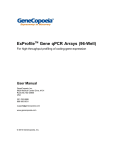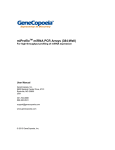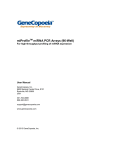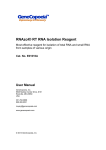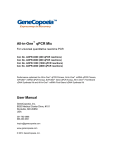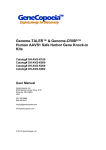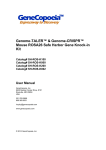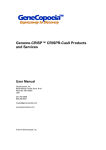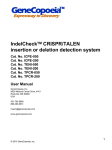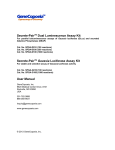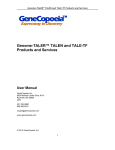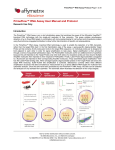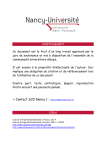Download ExProfile™ gene qPCR array user manual
Transcript
ExProfileTM Gene qPCR Arrays For high-throughput profiling of coding-gene expression User Manual GeneCopoeia, Inc. 9620 Medical Center Drive, #101 Rockville, MD 20850 USA 301-762-0888 866-360-9531 [email protected] www.genecopoeia.com © 2013 GeneCopoeia, Inc. ExProfileTM Gene qPCR Array User Manual USER MANUAL ExProfileTM Gene qPCR Array I. Introduction II. Array Format and Layout III. Arrays and Reagents IV. Preparation V. Procedure VI. Data Analysis VII. Appendix I VIII. Appendix II IX. Limited Use License and Warranty I. Introduction TM The ExProfile Gene qPCR Arrays are designed for profiling the expressions of pre-defined or customized sets of coding-genes in various tissues or cells. The differential expressions of profiled genes help researchers to identify and/or validate those that are biologically significant and important for their research. For catalog arrays, each 96-well plate contains up to 84 pairs of qPCR primers (each 384well plate contains up to 360 pairs of qPCR primers), which have been pre-validated and coated in designated wells. In the same plate, there are 12 wells in 96-well plate (or 24 wells in 384-well plate) that contain different types of controls for monitoring the efficiency of the entire experimental process: from reverse transcription to qPCR reaction. TM The All-in-One First-Strand cDNA Synthesis Kits (AORT-0020, AORT-0060) and the ® TM SYBR Green-based All-in-One qPCR Mix (AOPR-0200, AOPR-1000, AOPR-4000) are the designed reagents for use with the ExProfile gene qPCR arrays. These reagents have been optimized to produce high sensitivity, efficiency, and specificity. Similar reagents from thirdparty vendors may be compatible with the arrays but not recommended. Key advantages Validated primers Each pair of primers for a specific gene is designed using a proprietary algorithm and has been experimentally validated. Robust performance Sensitive – Detects as low as 4 copies of RNA using ExProfile gene qPCR array and recommended reagents/conditions. Broad linearity – Simultaneously detects mRNAs at different expression levels. 2 Reproducible – High reproducibility (R > 0.99) for inter-array and intra-array replicates. Genome-wide coverage for large selection of catalog and custom arrays Catalog arrays for pathway analysis, cancer research and other focused studies Customized arrays for researcher-selected gene groups Flexible compatibility Arrays are available in multiple plate formats to ensure compatibility with most commercial RT-PCR instruments. 2 ExProfileTM Gene qPCR Array User Manual Convenient data analysis Developed specially for ExProfile arrays, a data analysis tool is available for convenient data processing and statistical analysis. Protocol overview Figure 1. Gene qPCR array experiment work flow 3 ExProfileTM Gene qPCR Array User Manual Performance data Linear Range and Sensitivity (spike-in control RNA) 40.00 y = -2.4398x + 40.468 R² = 0.9962 35.00 Ct value 30.00 25.00 20.00 15.00 10.00 0 2 4 log5[copies] 6 8 Figure 2. Broad linear range and high sensitivity Mouse total RNA with serially diluted Spike-in control RNA were reverse-transcribed using All-in-One first strand cDNA synthesis kit. The reverse-transcribed cDNA samples were detected using All-in-One qPCR mix and spike-in control specific primers deposited in a 96-well plate. The resulting Ct values were plotted against the log5 of the amounts of spike-in control RNA. The data demonstrated a broad 6 linear dynamic range from 4 to 1.6*10 copies of input RNA as well as high sensitivity. 120% Positive calls 100% 80% 60% 40% 20% 0% 384ng 76.8ng 15.36ng 3.072ng 0.6144ng input RNA in qPCR reaction Figure 3. High positive calls with as little as 15.36 ng of total RNA Different amounts of MCF_7 total RNA (1000, 200, 40, 8, 1.6ng) were analyzed with the Human Breast Cancer Gene qPCR Array (PAG-HGBE96-01).The percentage of positive calls (Ct < 35) is plotted against the input amount of total RNA in each qPCR reaction. 4 ExProfileTM Gene qPCR Array User Manual Inter-array reproducibility Ct value of plate B 40.00 y = 0.9984x + 0.1567 R² = 0.9919 30.00 20.00 10.00 0.00 0.00 10.00 20.00 30.00 40.00 Ct value of plate A Figure 4. High inter-array reproducibility Two ExProfile qPCR gene array replicates (plate A and B) were analyzed using human total RNA (10tissue mix) on the Bio-Rad iQ5. The Ct values of the replicate plates were plotted against each other. 2 2 R > 0.99 was observed for high inter-array reproducibility. R > 0.99 was also observed for intra-array reproducibility (data not shown). II. Array Format and Layout Array format options Important note: Upon receiving, please check to make sure that the correct array format was ordered to ensure the compatibility with your qPCR instrument. GeneCopoeia provides five qPCR array formats (A, B, C, D, and E) suitable for use with the following real-time cyclers. Plate format Instrument provider qPCR instrument model A (96-well) Applied Biosystems 5700, 7000, 7300, 7500, 7700, 7900HT (Standard 96-well block), ViiATM7 (Standard 96-well block) B (96-well) Applied Biosystems 7500 (Fast block), 7900HT (Fast block), StepOnePlusTM, ViiATM7 (Fast block) C (96-well) Bio-Rad Laboratories iCycler iQ , MyiQ™, iQ™5 D (96-well) Bio-Rad Laboratories CFX96™, DNA Engine Opticon™, DNA Engine Opticon 2™,Chromo4™ E (96-well) Roche Applied Science LightCycler 480 (96-well block) F (384-well) Applied Biosystems 7900HT (384-well block),ViiA 7 (384-well block) G (384-well) Bio-Rad Laboratories Bio-Rad CFX384™ 384-well H (384-well) Roche Applied Science Roche LightCycler 480 (384-well block) ® ® 5 ExProfileTM Gene qPCR Array User Manual Catalog Array layout A TM Figure 5. Illustration of ExProfile B gene qPCR array layout (A: 96-well plate, B: 384-well plate) RNA primer pairs: Wells 1-84 are designated for a real-time PCR assay for genes. HK1-6: Six pre-deposited housekeeping gene (HK1-6) primer pairs, which can be used as endogenous positive controls as well as for array normalization. GDC: Genomic DNA Controls, which can be used to specifically detect genomic DNA contamination with a high level of sensitivity. RT: Spike-in RNA reverse transcription controls, which can be used to monitor the efficiency of the RT reactions. These pre-deposited primer pairs specifically amplify the cDNA template reversed transcribed from the spike-in exogenous RNA in the sample. PCR: Positive PCR controls, which are used to verify the PCR efficiency by amplifying the pre-deposited DNA template with its specific pre-deposited primer pairs. III. Arrays and Reagents Catalog arrays For a complete list of catalog arrays, please see Appendix II or visit following webpage. http://www.genecopoeia.com//product/gene-qpcr-array/. RT-PCR and RNA extraction reagents (sold separately) 6 ExProfileTM Gene qPCR Array User Manual Cat. No. Products Quantity/set Shipping and storage condition AORT-0020 AORT-0060 All-in-One first-strand cDNA synthesis kit 20 reactions 60 reactions Shipped with an ice-pack Stable for at least 6 months when stored at -20°C AOPR-0200 AOPR-1000 AOPR-4000 All-in-One qPCR mix 200 reactions Shipped with an ice-pack 1000 reactions Stable for at least 6 months when stored at 4000 reactions -20°C E01010A RNAzol® RT RNA isolation reagent 50 ml TM Shipped at room temperature. Stable for at least two years when stored at room temperature. Other materials required but not provided Total RNA extraction kit (RNAzol® RT RNA extraction reagent is recommended) DNase/RNase free tips, PCR reaction tubes, 1.5 ml microcentrifuge tubes 5 ml and 10 ml graduated pipettes, beakers, flasks, and cylinders 10 μl to 1,000 μl adjustable single channel micropipettes with disposable tips 5 μl to 20 μl adjustable multichannel micropipette, disposable tips, and reservoir qPCR instrument, compatible with gene qPCR arrays ordered IV. Preparation Important notes 1. Before use, remove any condensation that has accumulated on the plate sealing surface and centrifuge plates briefly to collect the contents to the bottom of the plate wells. 2. Strictly follow the standard procedures for qPCR to avoid nucleic acid contamination and non-specific amplifications. 3. Read the instructions thoroughly before attempting to perform the procedures. Estimates of RNA and number of RT-PCR reactions required for EACH SAMPLE Array format 96-well plate 384-well plate Number of plates per sample Total RNA recommended per sample Number of RT reactions per sample Number of qPCR reactions per sample 2 0.04-2 μg 1 220 5 0.12-6 μg 3 550 10 0.2-10 μg 5 1,100 20 0.4-20 μg 10 2,200 40 0.8-40 μg 20 4,400 1 0.08-4 μg 2 450 2 0.16-8 μg 4 900 5 0.4-20 μg 10 2,250 10 0.8-40 μg 20 4,500 RNA quantification and quality control 1. Dilute the RNA sample with the RNase-free water and measure the absorbance at 260 nm and 280 nm. A260/280 should be greater than 1.8. 7 ExProfileTM Gene qPCR Array User Manual 2. Use the formula A260 × dilution × 40 = μg RNA/mL to determine the RNA concentration. 3. Check the RNA integrity by agarose electrophoresis. Genomic DNA contamination control The Genomic DNA Control (GDC) in each ExProfile gene qPCR array specifically tests for genomic DNA contamination in each sample during each qPCR performance. A Ct value of genomic DNA control less than 35 indicates the presence of a detectable amount of genomic DNA contamination that should be addressed. So it is necessary to remove genomic DNA and all residual contamination from your RNA samples. V. Procedure First-strand cDNA synthesis Note: High-quality cDNA is a prerequisite for accurate detection of gene expression. It is important to remove genomic DNA and all residual contamination from your RNA samples before using our All-in-One First Strand cDNA Synthesis Kit. 1. Thaw all reverse transcription reagents from the First Strand cDNA Synthesis Kit. Mix reagents well by gently inverting the tubes. Centrifuge briefly and place on ice. 2. Prepare the RNA–primer mix: Add the following reagents to an RNase-free reaction tube that has been placed on ice. The final volume is 13μl. Component Volume Final concentration 1 μg Total RNA a Spike-in control RNA 1 ul 0.08 ng Random primer (250 μM) 1 μl 10 μM Oligo (dT)18 (60 μM) 1 μl 2.4 μM ddH2O(RNase/DNase free) to final 13 μl a. b. b The final concentration given is recommended. Each reaction can contain 10ng to 5μg total RNA. Low-abundance RNA may not be detected when using less than 10ng total RNA. Using both the Random Primer and the Oligo(dT)18 primer is recommended for optimal reaction efficiency. 3. Mix thoroughly and centrifuge briefly. Heat the RNA–primer mix (from step 2) at 65°C for 10 minutes to denature the RNA. After incubation, cool immediately on ice then centrifuge briefly. 4. Prepare the reverse-transcription master mix, keeping the tubes (from step 3) on ice while working. The final volume is 25μl. Component Volume RNA–primer mix 13μl 5 × RT Reaction Buffer 5μl 1× dNTP (25mM) 1μl 1mM RNase Inhibitor(25 U/μl) 1μl 1U/μl M-MLV RTase(200U/μl) 1μl 8U/μl ddH2O (RNase/DNase free) to final 25μl 8 Final concentration ExProfileTM Gene qPCR Array User Manual 5. Prepare the reverse transcription reaction by adding the reverse-transcription master mix to the RNA–primer mixture. Mix thoroughly and centrifuge briefly. Incubate at 37°C for 60 minutes. 6. Terminate the reaction by heating at 85°C for 5 minutes. 7. Add 225μl sterile water to each 25μl of reverse transcription reaction (1:10dilution). Mix thoroughly and centrifuge briefly. qPCR reaction Note: Be sure the ExProfile gene qPCR Array plate is compatible with your qPCR instrument before beginning this protocol. 1. Thaw the reagents of All-in-One qPCR Mix Kit. Invert the tubes to mix gently but thoroughly. Briefly centrifuge to bring the contents to the bottom of the tubes and then place them on ice. 2. Remove any condensation that has accumulated on the plate sealing surface and centrifuge briefly to collect the contents to the bottom of the plate wells. Carefully remove sealing film before use 96-Well qPCR. 3. Prepare qPCR solution on ice a Components 1 well N well 2×All-in-One qPCR Mix 10μl 11μl × N 1μl 1.1μl × N 0.4μl 0.44μl× N 9μl 8.6μl 20μl 9.9μl× N 9.5μl× N 22μl× N cDNA(10 times dilution) b 50 X Rox Reference Dye ddH2O ■ Not using Rox Reference Dye ■ Using Rox Reference Dye Final Volume a. b. The ExProfile gene qPCR array is used to detect multiple genes simultaneously in the same sample. Ensure sufficient mix is available by preparing enough for the number of reactions to be used with a 10% additional volume for pipetting loss. 50×Rox Reference Dye is added only for qPCR instruments that require ROX for calibration. 4. Mix the qPCR solution thoroughly and centrifuge briefly. Accurately transfer exactly 20 μl reaction mix to each well. Change tips after each transfer to avoid cross-contamination. 5. Tightly seal the qPCR reaction plate with a new sealing film, Ensure that the film seals smoothly to prevent refraction of light, and tightly to prevent from evaporation loss. Centrifuge briefly in order to remove bubbles. 6. Run qPCR. The following three-step PCR program is recommended for running qPCR. Cycles 1 40 a. b. c. Steps Temperature Duration Initial denaturation Denaturation Annealing Extension 95°C 95°C b 60°C c 72°C 10min 10sec. 20 sec. 15 sec. a Detection No No No Yes The DNA polymerase used in the 2X All-in-One qPCR Mix is a special chemically modified hotstart enzyme. The indicated initial denaturation is sufficient to activate the enzyme. The annealing temperature of the cross-linked primer is 60°C when using the optimized All-inOne qPCR Mix. The extension time indicated above is suitable for Bio-Rad’s iQ5 real-time PCR instrument. Adjust the time duration according to the documentation provided with your instrument. When using SYBR Green dye to monitor the qPCR reaction, a melting curve analysis should be performed immediately after qPCR cycling. 9 ExProfileTM Gene qPCR Array User Manual Temperature range Heating rate Constant temperature Detection 72°C~95°C 0.5°C/unit time 10sec./unit time Yes 30 sec No 25°C VI. Data Analysis 1. Define the baseline The baseline is the noise level in early cycles. Each real-time PCR instrument has algorithms to perform the baseline-setting. This may be a fixed number of cycles for all samples or adaptive for each sample, depending on the type of instrument that is being used. If the lowest Ct is less than the upper limit of the baseline setting, then the baseline should be manually adjusted. Use the “Linear View” of the amplification plot to determine the earliest visible amplification, and then set the baseline from cycle 2 to two cycles before the earliest visible amplification. Normally it is between 2 to 10 cycles. Do not use cycles greater than 15. Ensure that baseline settings are the same across all PCR runs in the same analysis to allow comparison of results. 2. Set threshold Correct placement of the threshold is the next crucial step in data analysis. To adjust the threshold properly, set the threshold value within the exponential phase of all amplification plots when viewed using the logarithmic scale for the y axis. Generally, the expression level of each reference gene should be higher than most other genes. 3. Obtain the Ct or Cp values The Ct is defined as the cycle when sample fluorescence exceeds a chosen threshold above background fluorescence. This is also known as the Cp or crossing point. 4. Export the data. Most qPCR instruments provide a function for exporting Ct or Cp values to Excel. 5. Analyze the qPCR results using the ΔΔCt method of relative quantification and interpretation of the control wells. 6. All Ct values reported as greater than 35 or as N/A (not detected) are considered as not detectable. QC analysis 1. Examined amplification and melting status of each gene using the qPCR instrument software. Each reference gene, RT control and PCR control should exhibit only one melting peak per reaction. 2. Examined CT values of the genomic DNA contamination wells (GDC). A CT values of genomic DNA control should be more than 35, which indicate a little of genomic DNA contamination can not effect the real-time gene expression profiling result. 3. Examined CT values of the RT control and positive PCR control wells (PCR). If the RNA sample is of high quality, the cycling program has been correctly run, and the thresholds have been correctly defined, the value of Ct of RT control should be 20±3, and the value of Ct of PCR should be 20±2 across all arrays or samples. Data analysis Analyze the qPCR result with GeneCopoeia’s online Data Analysis System (free), which is available at http://www.genecopoeia.com/product/gene-qpcr-array/#Analysis_Tool. This Data Analysis System uses the ΔΔCt method to perform fold-change analysis or simple statistical analysis of the expression level (Ct or Cp values) for each gene. 1. Download and read the “Primer Array Date Analysis Operation Guide” before performing analysis. 10 ExProfileTM Gene qPCR Array User Manual 2. Import the Ct or Cp values into the corresponding data analysis template form (Sample Data.xls and Control Data.xls). Upload the template form and choose the correct reference and analysis factors. Note: The reference factor chosen for qPCR Primer Array for normalization with the ΔΔC t method must not be influenced by the experimental design. Therefore use one or more factors that have been previously verified experimentally. A single value or an average of the Ct values for the reference factor can be used for normalization. 3. Perform the specified analysis. When a test is repeated at least three times, statistical results (p value) are provided. The analysis results allow genes of interest to be simply and rapidly selected for further study. VII. Appendix I ΔΔCt data analysis method ΔΔCt data analysis, a relative quantitative analysis technique, is the most simple and direct method for gene expression analyses. The method requires stable expression from a reference gene to normalize the variation introduced by each step, including sample collection, RNA isolation, reverse transcription and amplification. Typically housekeeping genes are used as reference genes. In qPCR, as in any amplification-based technique, the number of amplification products (N) is calculated as follows: Ct N =N0× (1+E) N0: number of template molecules Ct: threshold cycle E: amplification efficiency When the amplification efficiency E is 100%, the number of template molecules in preamplification mix is calculated as follows: -Ct N0 =N × 2 To analyze the change in expression level for the gene of interest in multiple samples using the ΔΔCt method, the amount of the amplification template from different samples is normalized by dividing the expression level of the gene of interest (x) with the reference factor (r) as follows: -Ctx -Ctr -(Ctx - Ctr) -ΔCt Nrel = N0x/N0r =N × 2 / N ×2 =2 =2 The change in normalized expression levels of the gene of interest (x) between experimental sample (sample 1) and the control sample (sample 2) is as follows: -ΔCt1 -ΔCt2 -(ΔCt1- ΔCt2) -ΔΔCt Nrel1/Nrel2=2 /2 =2 =2 The value of 2 samples. VIII. -ΔΔCt is the change in expression level of the gene of interest between different Appendix II Catalog ExProfile gene qPCR array list Cat. No. PAG-HCAD96 qPCR array products Quantity/set Shipping and storage condition Shipped at room temperate ExProfileTM Human Adenocarcinoma 168 genes Stable for at least 6 months Gene qPCR Array 2 x 96-well plate when stored at -20°C 11 ExProfileTM Gene qPCR Array User Manual PAG-HCBA96 ExProfileTM Human Brain Cancer Gene qPCR Array Shipped at room temperate 252 genes Stable for at least 6 months 3 x 96-well plate when stored at -20°C PAG-HCBE96 ExProfileTM Human Breast Cancer Gene qPCR Array Shipped at room temperate 504 genes Stable for at least 6 months 6 x 96-well plate when stored at -20°C PAG-HCBL96 ExProfileTM Human Bladder Cancer Gene qPCR Array Shipped at room temperate 420 genes Stable for at least 6 months 5 x 96-well plate when stored at -20°C PAG-HCCR96 ExProfileTM Human Colorectal Cancer Gene qPCR Array Shipped at room temperate 336 genes Stable for at least 6 months 4 x 96-well plate when stored at -20°C PAG-HCCV96 ExProfileTM Human Cervical Cancer Gene qPCR Array Shipped at room temperate 84 genes Stable for at least 6 months 1 x 96-well plate when stored at -20°C PAG-HCED96 ExProfileTM Human Endometrial Cancer Gene qPCR Array Shipped at room temperate 82 genes Stable for at least 6 months 1 x 96-well plate when stored at -20°C PAG-HCNN96 ExProfileTM Human Head and Neck Cancer Gene qPCR Array Shipped at room temperate 504 genes Stable for at least 6 months 6 x 96-well plate when stored at -20°C PAG-HCKD96 ExProfileTM Human Kidney Cancer Gene qPCR Array Shipped at room temperate 84 genes Stable for at least 6 months 1 x 96-well plate when stored at -20°C PAG-HCLK96 ExProfileTM Human Leukemia Gene qPCR Array Shipped at room temperate 504 genes Stable for at least 6 months 6 x 96-well plate when stored at -20°C PAG-HCLU96 ExProfileTM Human Lung Cancer Gene qPCR Array Shipped at room temperate 504 genes Stable for at least 6 months 6 x 96-well plate when stored at -20°C PAG-HCLV96 ExProfileTM Human Liver Cancer Gene qPCR Array Shipped at room temperate 168 genes Stable for at least 6 months 2 x 96-well plate when stored at -20°C PAG-HCLY96 ExProfileTM Human Lymphoma Cancer Gene qPCR Array Shipped at room temperate 420 genes Stable for at least 6 months 5 x 96-well plate when stored at -20°C ExProfileTM Human Myeloma Shipped at room temperate 84 genes Stable for at least 6 months 1 x 96-well plate when stored at -20°C PAG-HCML96 Gene qPCR Array PAG-HCOV96 ExProfileTM Human Ovarian Cancer Gene qPCR Array Shipped at room temperate 336 genes Stable for at least 6 months 4 x 96-well plate when stored at -20°C PAG-HCPC96 ExProfileTM Human Pancreatic Cancer Gene qPCR Array Shipped at room temperate 168 genes Stable for at least 6 months 2 x 96-well plate when stored at -20°C PAG-HCPS96 ExProfileTM Human Prostate Cancer Gene qPCR Array Shipped at room temperate 412 genes Stable for at least 6 months 5 x 96-well plate when stored at -20°C PAG-HCSK96 ExProfileTM Human Skin Cancer Gene qPCR Array Shipped at room temperate 252 genes Stable for at least 6 months 3 x 96-well plate when stored at -20°C 12 ExProfileTM Gene qPCR Array User Manual PAG-HCSM96 Shipped at room temperate ExProfileTM Human Stomach Cancer 168 genes Stable for at least 6 months Gene qPCR Array 2 x 96-well plate when stored at -20°C PAG-HCTR96 ExProfileTM Human Thyroid Cancer Gene qPCR Array Shipped at room temperate 84 genes Stable for at least 6 months 1 x 96-well plate when stored at -20°C PAG-HCTT96 ExProfileTM Human Testicular Cancer Gene qPCR Array Shipped at room temperate 68 genes Stable for at least 6 months 1 x 96-well plate when stored at -20°C PAG-HPCD96 ExProfile Human Cancer Drug Resistance & Metabolism Related Gene qPCR Array PAG-HPCR96 Shipped at room temperate TM ExProfile Human Cytokine 84 genes Stable for at least 6 months Receptor Related Gene qPCR Array 1 x 96-well plate when stored at -20°C PAG-HPEP96 ExProfile Human EGF/PDGF Signaling Related Gene qPCR Array PAG-HPFT96 ExProfile Human FoxP3 Target Genes qPCR Array PAG-HPGT96 ExProfile Human Growth and Shipped at room temperate 84 genes Development Toxicity Related Gene Stable for at least 6 months 1 x 96-well plate qPCR Array when stored at -20°C PAG-HPHI96 Shipped at room temperate TM ExProfile Human Insulin Signaling 84 genes Stable for at least 6 months Related Gene qPCR Array 1 x 96-well plate when stored at -20°C PAG-HPIA96 ExProfile Human Innate & Adaptive Immune Response Related Gene qPCR Array PAG-HPIC96 ExProfile Human Inflammatory Cytokines & Receptors Relayed Gene qPCR Array PAG-HPIF96 ExProfile Human Interferon Signaling & Response Related Gene qPCR Array PAG-HPII96 ExProfile Human Innate Immune Signaling Related Gene qPCR Array PAG-HPIN96 ExProfile Human Interferon Related Gene qPCR Array PAG-HPJS96 ExProfile Human JAK/STAT Signaling Related Gene qPCR Array PAG-HPKA96 ExProfile Human NFΚΒ Signaling Pathway Related Gene qPCR Array PAG-HPPK96 ExProfile Human PI3K-AKT Signaling Realted Gene qPCR Array TM Shipped at room temperate 84 genes Stable for at least 6 months 1 x 96-well plate when stored at -20°C TM Shipped at room temperate 84 genes Stable for at least 6 months 1 x 96-well plate when stored at -20°C TM Shipped at room temperate 84 genes Stable for at least 6 months 1 x 96-well plate when stored at -20°C TM TM Shipped at room temperate 84 genes Stable for at least 6 months 1 x 96-well plate when stored at -20°C TM Shipped at room temperate 84 genes Stable for at least 6 months 1 x 96-well plate when stored at -20°C TM Shipped at room temperate 84 genes Stable for at least 6 months 1 x 96-well plate when stored at -20°C TM Shipped at room temperate 84 genes Stable for at least 6 months 1 x 96-well plate when stored at -20°C TM Shipped at room temperate 84 genes Stable for at least 6 months 1 x 96-well plate when stored at -20°C TM Shipped at room temperate 84 genes Stable for at least 6 months 1 x 96-well plate when stored at -20°C TM Shipped at room temperate 84 genes Stable for at least 6 months 1 x 96-well plate when stored at -20°C TM Shipped at room temperate 84 genes Stable for at least 6 months 1 x 96-well plate when stored at -20°C 13 ExProfileTM Gene qPCR Array User Manual TM Shipped at room temperate 84 genes Stable for at least 6 months 1 x 96-well plate when stored at -20°C TM Shipped at room temperate 84 genes Stable for at least 6 months 1 x 96-well plate when stored at -20°C TM Shipped at room temperate 84 genes Stable for at least 6 months 1 x 96-well plate when stored at -20°C TM Shipped at room temperate 84 genes Stable for at least 6 months 1 x 96-well plate when stored at -20°C PAG-HPRA96 ExProfile Human Inflammatory Response and Autoimmunity Related Gene qPCR Array PAG-HPST96 ExProfile Human Signal Transduction Related Gene qPCR Array PAG-HPTB96 ExProfile Human T-cell and B-cell Activation Related Gene qPCR Array PAG-HPTC96 ExProfile Human Cell Cycle Toxicity and Cancer Related Gene qPCR Array PAG-HPTG96 Shipped at room temperate TM ExProfile Human TGF-β Signaling 84 genes Stable for at least 6 months Related Gene qPCR Array 1 x 96-well plate when stored at -20°C PAG-HPTH96 ExProfile Human Th1-Th2-Th3 Related Gene qPCR Array PAG-HPTM96 ExProfile Human Tumor Metastasis Related Gene qPCR Array PAG-HPTS96 PAG-CS TM Shipped at room temperate 84 genes Stable for at least 6 months 1 x 96-well plate when stored at -20°C TM Shipped at room temperate 84 genes Stable for at least 6 months 1 x 96-well plate when stored at -20°C ExProfile Human T helper 17 (Th17) Related Gene qPCR Array TM Shipped at room temperate 84 genes Stable for at least 6 months 1 x 96-well plate when stored at -20°C ExProfileTM Custom Gene qPCR Arrays Variable Shipped at room temperate Stable for at least 6 months when stored at -20°C Note: New catalog ExProfile gene qPCR arrays will be continuously added to the product line. Check out http://www.genecopoeia.com//product/gene-qpcr-array/ 14 ExProfileTM Gene qPCR Array User Manual IX. Limited Use License and Warranty Limited use license Following terms and conditions apply to use of ExProfileTM Gene qPCR Arrays (the Products). If the terms and conditions are not acceptable, the Product in its entirety must be returned to GeneCopoeia within 5 calendar days. A limited End-User license is granted to the purchaser of the Product. The Product shall be used by the purchaser for internal research purposes only. The Product is expressly not designed, intended, or warranted for use in humans or for therapeutic or diagnostic use. The Product must not be resold, repackaged or modified for resale, or used to manufacture commercial products or deliver information obtained in service without prior written consent from GeneCopoeia. This Product should be used in accordance with the NIH guidelines developed for recombinant DNA and genetic research. Use of any part of the Product constitutes acceptance of the above terms. Limited warranty GeneCopoeia warrants that the Product meets the specifications described in the accompanying Product Datasheet. If it is proven to the satisfaction of GeneCopoeia that the Product fails to meet these specifications, GeneCopoeia will replace the Product. In the event a replacement cannot be provided, GeneCopoeia will provide the purchaser with a refund. This limited warranty shall not extend to anyone other than the original purchaser of the Product. Notice of nonconforming products must be made to GeneCopoeia within 30 days of receipt of the Product. GeneCopoeia’s liability is expressly limited to replacement of Product or a refund limited to the actual purchase price. GeneCopoeia’s liability does not extend to any damages arising from use or improper use of the Product, or losses associated with the use of additional materials or reagents. This limited warranty is the sole and exclusive warranty. GeneCopoeia does not provide any other warranties of any kind, expressed or implied, including the merchantability or fitness of the Product for a particular purpose. GeneCopoeia is committed to providing our customers with high-quality products. If you should have any questions or concerns about any GeneCopoeia products, please contact us at 301-762-0888. © 2013 GeneCopoeia, Inc. GeneCopoeia, Inc. 9620 Medical Center Drive, Suite 101 Rockville, MD 20850 +1 (301) 762-0888 +1 (866) 360-9531 [email protected] GeneCopoeia Products are for Research Use Only Copyright © 2013 GeneCopoeia, Inc. Trademarks: GeneCopoeia™, miProfile™, All-in-One™, miProfile™ (GeneCopoeia Inc.); SYBR® (Molecular Probes);iCycler iQ®, MyiQ™, ® ® ® iQ™5 , CFX96™, DNA Engine Opticon™, DNA Engine Opticon 2™, Chromo4™ (Bio-Rad); LightCycler (Roche);Trizol™, ABI , ROX , ViiATM, StepOnePlusTM (Life Technologies); RNAzol® (Molecular Research Center, Inc.); NanoDrop™ (Thermo Scientific). PAG062613 15















